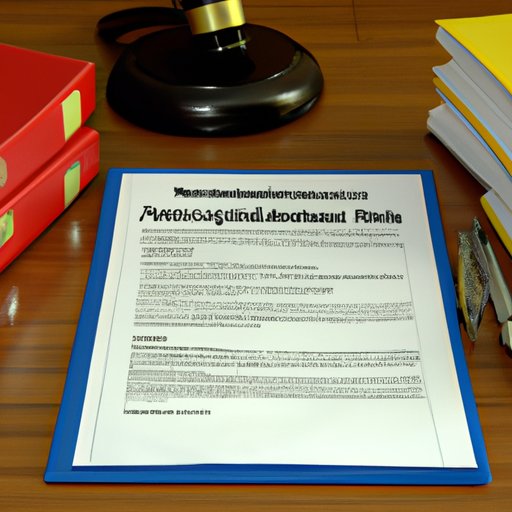Introduction
A restraining order is a legal document that requires a person to stay away from another person or place. It is also referred to as a “protection order” or “order of protection.” Restraining orders are issued by courts and provide legally binding instructions for the person being restrained to follow.
The primary purpose of a restraining order is to protect the safety of an individual who has been threatened, harassed, or otherwise harmed. This article will provide a comprehensive overview of the process of putting a restraining order on someone and discuss the legal requirements, potential consequences, and resources available to help with the process.

Process for Filing for a Restraining Order
The process for filing for a restraining order varies depending on the state in which you reside and the type of restraining order being sought. Generally speaking, the following steps must be taken in order to obtain a restraining order:
- Identify the type of restraining order needed
- Gather evidence of the need for the restraining order
- File a petition with the court
- Attend a hearing
- Wait for the judge’s decision
The first step in the process is to identify the type of restraining order needed. Different types of restraining orders have different legal requirements and processes, so it is important to make sure that the correct type of restraining order is sought.
Once the type of restraining order is determined, the next step is to gather evidence of the need for the restraining order. This evidence can include documents, photographs, recordings, and witness statements. This evidence should be presented to the court when filing the petition.
The petition should be filed in the county in which the petitioner (the person seeking the restraining order) resides or in the county where the respondent (the person against whom the restraining order is sought) lives. The petition should include all relevant information regarding the situation, such as the names of the parties involved, the nature of the threat or harm, and the requested order of protection.
After the petition is filed, both parties will receive a notice to attend a hearing. At the hearing, both parties can present their case to the judge. The judge will then decide whether or not to grant the restraining order. If the restraining order is granted, it will remain in effect until the expiration date listed in the order.

Impact of Getting a Restraining Order on the Person Being Restrained
Getting a restraining order can have serious legal and emotional consequences for the person being restrained. Depending on the type of restraining order, the respondent may be prohibited from having contact with the petitioner, entering their home or workplace, or possessing firearms. The respondent may also face criminal charges if they violate the terms of the restraining order.
In addition to the legal implications, getting a restraining order can also have emotional and financial consequences for the person being restrained. They may feel isolated or ashamed, and they may experience difficulty in finding employment or housing due to the stigma associated with restraining orders.
Types of Restraining Orders Available
There are several different types of restraining orders available, including domestic violence restraining orders, civil harassment restraining orders, and workplace violence restraining orders. Each type of restraining order has its own set of legal requirements and processes.
Domestic violence restraining orders are designed to protect victims of domestic abuse. These restraining orders typically require the respondent to stay away from the petitioner, as well as to refrain from threatening or harassing them. In some states, these restraining orders may also require the respondent to surrender any firearms they possess.
Civil harassment restraining orders are intended to protect individuals from unwanted contact or communication from another person. These restraining orders can be used to protect individuals from stalking, harassment, or other forms of intimidation. These restraining orders may also prohibit the respondent from entering certain locations or contacting specific people.
Workplace violence restraining orders are designed to protect employees from threats or acts of violence in the workplace. These restraining orders may require the respondent to stay away from the workplace or to refrain from contacting certain individuals.
Resources to Help with the Restraining Order Process
There are a variety of resources available to help individuals navigate the restraining order process. These resources include legal services, support groups, and online resources.
Legal services can provide assistance with the restraining order process and can help ensure that all necessary paperwork is completed correctly. Legal services can also provide advice on how to respond to the restraining order, as well as help with enforcement if necessary.
Support groups can provide emotional support to individuals going through the restraining order process. These groups can offer guidance, advice, and understanding to those dealing with the emotional impact of restraining orders.
Finally, there are a variety of online resources available that can provide information about restraining orders and the restraining order process. These resources can be a valuable source of information for those seeking to understand the process and the legal requirements.

Important Considerations When Putting a Restraining Order in Place
When putting a restraining order in place, there are several important considerations that must be taken into account. These considerations include reviewing state laws, exploring options for enforcement, and understanding the role of law enforcement.
It is important to review state laws before putting a restraining order in place, as the laws vary from state to state. It is also important to explore options for enforcement, as some restraining orders may require the assistance of law enforcement in order to be enforced.
Finally, it is important to understand the role of law enforcement when it comes to restraining orders. Law enforcement officers may be able to assist in enforcing the restraining order, but they cannot enforce the order on their own. It is important to know what steps must be taken in order for law enforcement to become involved.
Conclusion
Putting a restraining order on someone can be a complicated and intimidating process. It is important to understand the legal requirements, potential consequences, and resources available to help with the process. Additionally, it is important to consider the state laws, enforcement options, and role of law enforcement when putting a restraining order in place. If you are considering putting a restraining order in place, it is important to seek professional help in order to ensure that the process is handled correctly.
(Note: Is this article not meeting your expectations? Do you have knowledge or insights to share? Unlock new opportunities and expand your reach by joining our authors team. Click Registration to join us and share your expertise with our readers.)
